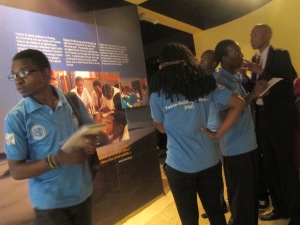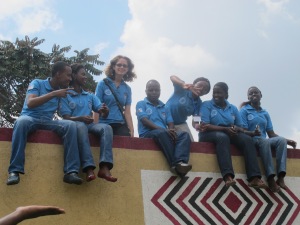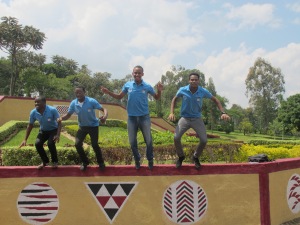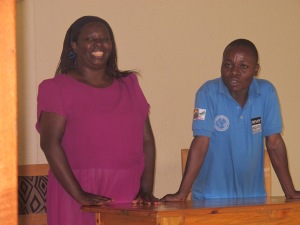Humorously told by Nyakiya Eston Ochieng (Participant from Kenya)
From day one, we looked into various components of this misfortune called genocide. We began by dissecting the concept of cross-cultural understanding and dialogue as the fundamental tenets on which prevention and resolution of conflict are based, visited the Gisozi (Kigali) Memorial site where over 250,000 victims of the genocide are buried, Came back, I think we ate, slept and woke up the following morning to begin our study, debates, discussions, deliberations and sessions on the stages of Genocide. My Burundian Colleague, a renowned blogger, Ms. Floriane Niyungeko, captured this so well in her blog post and to those of you who have been lucky enough to read her works, I hope her lucid explanations are not here in this piece overstated.


Through the schedule, we screened and discussed the “Ghosts of Rwanda” film clips as was captured in an earlier blog by DJ. Kambada Alex of Rwanda; a scholar and respected Mediator. (For clarity) He is not a cousin of the now imprisoned former Prime Minister- Kambada. We also had a session with CNLG- the National Commission for the Fight against Genocide, talked to the Director of Memory and Prevention of Genocide, asked questions, got answers-mostly directed to our Presidents and returned to the Hotel just in time to consume lunch and thereafter did a SWOT analysis on the Commission. Attorney Ssekandi, a Ugandan National, poet, writer and fellow erudite, captured this on his blog.
Then came the 1st day of 2014, in which we ate, danced and shared our stories. I also doubt if I did not sleep, for I remember yawning the following morning as I left my bed for breakfast. Ms. Merveill Kavira, the Honorable Delegate from DRC, has written volumes about this and made it available for future references in the Organization’s official page. Of Course with pictorial evidence which in the normal verisimilitude of modesty would summon a huge frown from my beloved grandmother, but thanks to the gods-she has until now remained hesitant to acquaint herself with basic IT nuggets, necessary for consumption of information in a digital world.

Hey! Enough of the recap! Not so?
Now it is my honour to share a summary of what occurred between the births of 2014 to when we arrived from Murambi. I Nyakiya, a humble servant of God, an upcoming husband and a human being, shall now take the floor and perform my duty.
From Thursday 2nd January to Saturday 3rd January 2014 we scrutinized the subject matter of Transitional Justice. After an introduction by Madame Betty- our facilitator, we developed a problem tree to explore the aftermath of genocide, its history, prevention and legal consequences. We then watched the film, “Long Coat”, got a presentation from Mr. Eduard Bamporiki then later another presentation from the Country Director of AEGIS Trust Mr.Freddy Mutanguha. The series of very informative presentations was closed by Mr.Kamanzi Innocent the ICTR Information Officer (Rwanda)
We tackled the subject matter of the aftermaths of genocide, its legal consequences and approaches of attaining justice for victims and survivors. We also studied the Gacaca Courts- their composition, mandate, effectiveness and the lessons from their operation to Rwanda and the world. We watched “Long Coat”, films by ICTR on the Gacaca sessions (successes and challenges), discussed the films and made recommendations. We also delved into the subject matter of Conflict dynamics and peace building and discussed conflict sensitivity and peace building. Later in the evening, we enjoyed a guided tour of Kigali town during which we saw very many things; among them the beautiful people of Rwanda, the very clean roadways and attractively green public gardens–We also saw a notice at Nakummat Supermarket about one dreaded thief who apart from being at large, was dangerous to the society and so, the society was somewhat advised to ‘scamper to safety’ whenever and wherever they could have seen him

Sunday morning, the 8th of January, we left Bellagio Hotel and headed for Nyanza in the Southern part of Rwanda, we visited the King’s Palace where we learnt about the king’s main house, the milk and beer houses of the ‘original’ kingdom, met the shepherds who sang to and moved through lyrics into a jig- the Inyambo breed of cattle (a reserve for the palace). We also visited the Modern palace of the Rwanda kingdom, built in 1932 and headed lastly by King Kigeri Ndahindurwa, the younger brother of King Mutara III Rudahigwa. We had a good tour of the palace, signed the visitors’ book (I personally signed below some Buganda Kingdom Prime Minister who had visited the previous day) as a reminder to future visitors that we arrived there before them. It will be wantonly silly I don’t mention the memorable stopover for Lunch at Boomerang Hotel before we headed for Butare, but stopping over for a session with a community group in Mukara Sector (Save). They welcomed us with a dance and an organized hand clapping which I have since then, christened as ‘Senorita’, we joined the dances, observed preliminary routines of introductions then settled for serious business as we listened to the testimonies of a former perpetrator (now forgiven and accepted and useful to the society), a transformed former rebel and a mother whose 3 out of four children and the husband were murdered. We learnt how the community is struggling to foster peace, empower themselves and confront the post-genocide era, asked questions, got answered, stood up, danced for the last time, paused for a group photo and left for the Bus after promising in one accord that the dark history should never again find a repeat in our society.
At about 1730hrs the same day, we checked in at St. Vincent motel (my room was very importantly, the biggest), had dinner, danced and slept. Oh sorry, we also had ‘drinks’ (Many thanks to Alex, Kessy and Ssekandi who are the only ones mandated to explain how rooms, in this particular occasion- gave birth to Konyagi). Morning came. Breakfast was attacked without apologies and after some forty minutes we were taking a walk to the Ethnographic Museum of Rwanda. At the museum we learnt about the history of the kingdom of Rwanda which had originally included parts of Uganda, Tanzania and Burundi, read the history of their traditional education system, agriculture, warfare, economy- Also ‘The drum’ (alternately called ndankurwanda and Ndanguburundi by the people of Burundi and Rwanda respectively during wars). We saw the ‘peace baskets’, the king’s carriage and the contents of a king’s tomb which was excavated in Gaseke in 1969. Walked out, giggled for photo sessions (regulated by comrade John from Germany), watched wonderful session of traditional dance and then left for the hotel for lunch but not before addressing the nation via local media. Lunch was good and after a short schedule of psychological preparedness, we set off for the Murambi Genocide Memorial Center.
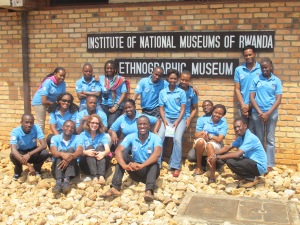
Through a dedicated aid of an attendant, we listened to the political history of Rwanda, systematic planning of Genocide with examples in 1959, 1972-1973 and finally culminating into the horrible memories of the 1994 heartbreaking bloodshed. We went through the architecture of the genocide ideology, from the pan-hutu mindset, anti-Tutsi proclamations, through to the killing of about 20,000 Tutsi’s by April 19994 in the region , responsibility of the French soldiers in training the militias and how the areas they controlled turned into sanctuaries of death. Elimination of the Tutsis and the final end of the genocide through a liberation front headed by then Gen. Paul Kagame of Rwanda Patriotic Front (RPF) and Now the Democratically elected President of the Peoples’ Republic of Rwanda. We sadly learnt that by the end of the genocide, about 1.2 people, mostly innocent civilians had been savagely murdered.
We saw a mass grave from which about 8000 bodies had been exhumed, the current mass grave hosting the mutilated bodies and 24 rooms, hosting 1000 dead bodies, including one of a man who was buried alive, a woman who suffered rape before her sad death, a child who tried to hide her face from the killers thinking she would escape but sadly, never did and the many other dead bodies, each holding in their stillness, a story of betrayal by fellow countrymen, a tale of tears that met blind eyes and cries that did not move the deaf hearts of the killers.
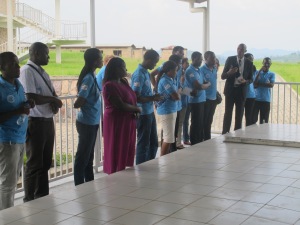
For personal reasons, I shall stop this narration here for I do not want to remind both myself and my readers that on this very place where thousands of innocent people-whose only offence was the Tutsi tag-were killed, is now hosting bodies of some of the children who would have grown to attend this would-be Technical school. I do not want to mention that after these people were buried in the mass graves that were dug by the government caterpillars, the French soldiers manning the station at that time, decided to cooperate with the militias and instead of defending the helpless, leveled the soils of the mass grave and made a volleyball pitch on top of thousands of dead people.
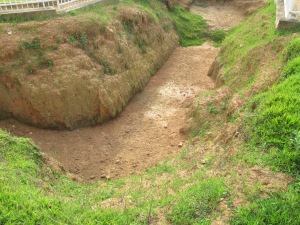
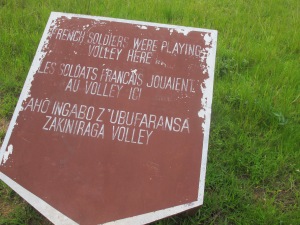
These were tearing experiences and since my good friend, a flamboyant politician and gallant son of Tanzanian, Mr. Francis Kessy, has told this story before, let me just conclude that after all these, we needed some internal peace for each of us before we drove back to Huye, had the last dinner at St. Vincent Hotel, slept (I missed somebody) and woke up the following day to take breakfast then left peacefully for an awaiting lunch at Bellagio Hotel on Tuesday. Please note that on our way back, apart from the fishponds, green houses and rice plantations that we saw, we also met the Nyabarongo River on which murdered victims of the genocide had floated into Lake Victoria to feed the fish and aquatic animals of the lake. It was painful and very sad, but we learnt, swore never to be used in violence. We arrived in Bellagio Hotel, more prepared to be peace builders than ever before.















